How to Think Like a Forest
4/11/24 – and why we should
Hello everyone:
As always, please remember to scroll past the end of the essay to read some curated Anthropocene news.
Now on to this week’s writing:
I hope that those of you who ventured out to see the eclipse experienced some awe amid the darkening. If there’s a music to the movement of the spheres, perhaps totality was a pause between notes? It certainly seemed that way for Heather and I as we watched the night sky appear suddenly above an ice-covered lake. The internet is full of eclipse stories and photos, so I won’t burden you with too much detail here, other than to provide a pair of images as a way of introducing this week’s topic.
We traveled three hours upcountry to a closed lakeside state park in central Maine, a location I chose because I thought the mile-plus walk in from the gate would deter the hordes driving up from southern New England. I was very wrong, and so we joined a long single-file line trudging through the snow in what I kept thinking looked like a cheerful reenactment of Klondike prospectors struggling up the Chilkoot Pass. Here too we sought a rare bit of shiny, ephemeral joy.
Nearly all of the crowd remained clumped in the lawn and beach area, while we and a few other antisocial types spread out through the hemlocks, cedars, and white pines to remote bits of shoreline where we awaited our darkling wonders. A thin veil of ice covered the lake, other than right along the shore, where we sprawled on sun-warmed stones. As soon as the eclipse began, though, Heather and I were back in the woods, prospecting for baby crescents.
Sure enough, at about half-totality they appeared everywhere on the snow, trunks, and stones of the dense forest. Where the eclipse-slanted light passed through the dense foliage of cedar and hemlock, pinhole threads of photons became mesmerizing, ephemeral documents of the Moon’s passing before the Sun. They fluttered like gull feathers and wings on hemlock trunks, shimmered like mares’ tail cirrus on the snow, and shone like fissures revealing white-hot light within the dark lichen-encrusted granite glacial erratics.
Suddenly the forest was a different place, more mysterious, in league with the heavens but open with its secrets, if only we care to look.
I’ve been thinking a lot about forests and their secrets lately, mostly because I’m finally reading Richard Powers’ brilliant and beautiful novel, The Overstory. I’m about two-thirds of the way through, at the point where Powers’ cast of characters are weaving together to defend what remains of the big trees in the western U.S. Grief, science, love and empathy stand, as best they can, in front of the machines of destruction, both mechanical and social.
If you haven’t read The Overstory, I highly recommend it. Powers’ storytelling and character-building are topnotch, and his prose is threaded with lyrical tributes to trees and forests like mycelia through old-growth soil. At the moment, though, I’m mulling a question the book repeatedly raises, at least for me: What does it means to think like a forest? What’s the leap in consciousness between the modern human mind and the far more ancient communal intelligence of plants, fungi and other microbes, and animals? I don’t have a good answer, much less a comprehensive one, but I can offer a few thoughts on the beauty, resilience, and importance of replanting a forest in our awareness.
As the eclipse reminded me, the more we hunt for the mysteries of forests, the more forms of light will be revealed.
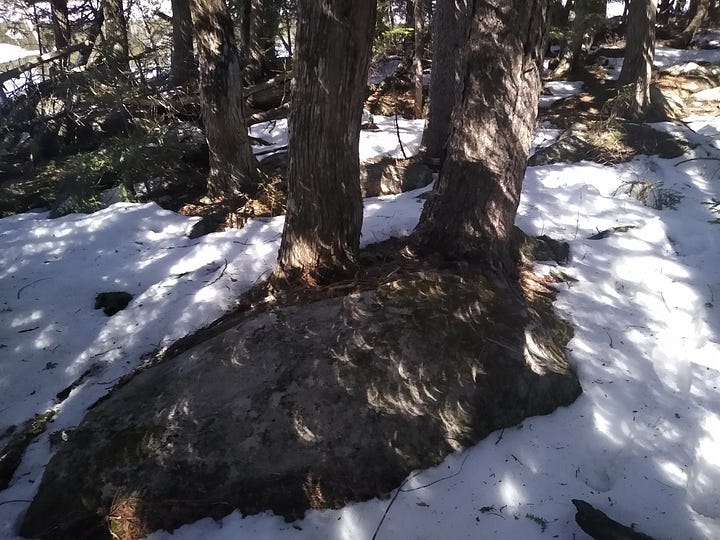
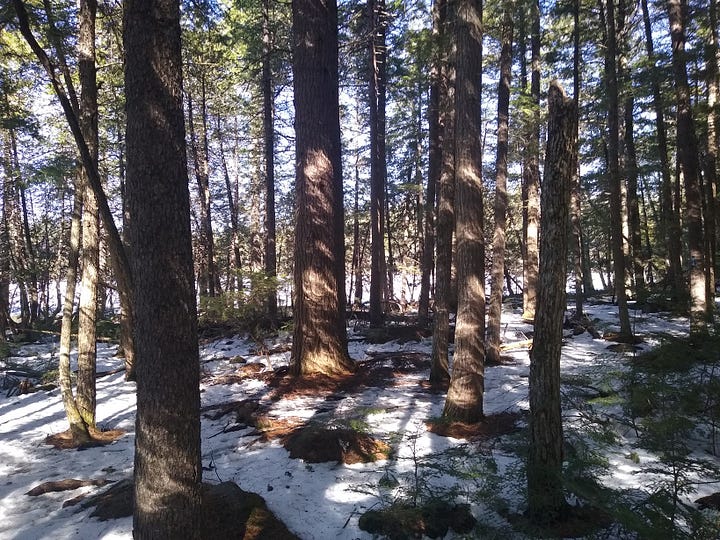
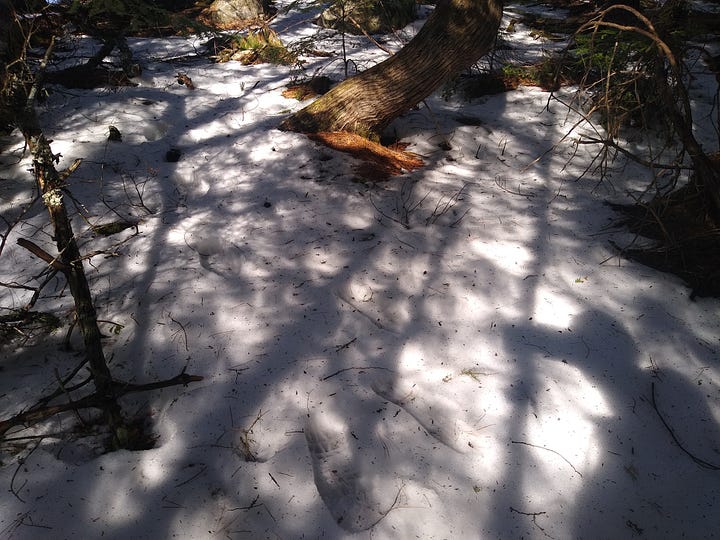

Enduring
I’m reminded almost daily of our absurd and catastrophic relationship with time, which we’ve fenced in and chopped up into abstract fragments in order to schedule our persistent dismantling of the world that plants have built from sunlight. Franz Kafka once scribbled into his notebooks that “All human errors are impatience, a premature breaking off of methodical procedure…”, and while he was likely talking about the logic errors of daily life, I hear an echo of the Anthropocene too, which is arguably more about time than place. Impatience is a machine.
The living world breathes on so many time scales, from the microscopic to the millennial, that it scarcely recognizes our sense of time at all. Nutrients, genes, and energy move in waves and circles, as change across ecosystems and landscapes occurs with the elegance of the surface of the sea. On a timeframe foreign to modern human sensibility, species come and go and communities change form. Forests have their “methodical procedures” too, though we are still largely ignorant of them. And that ignorance has led us to rupturing most Earth systems and erasing much of the planet’s primary forest in far less time than it takes for a redwood tree to reach maturity.
Our changes to the fundamental working of the Earth have happened so fast, i.e. on a human time scale, that natural systems will, for the foreseeable future, respond with chaos rather than evolution and adaptation. In our acceleration of extinctions, we’re slower than an asteroid, but not by much.
The solution is to inform policy and culture with the reality of deep time. To have empathy and respect for a forest is to allow it to live in its fullest communal expression, as primary and largely undisturbed growth. But for such an ethic to take root, the demand for resources must decline, which becomes even harder as we necessarily reduce global poverty levels while still growing population by another billion or two. Even now, in fact, as we wisely shift energy systems inexorably toward renewables, emissions are still reaching all-time highs and demand for energy is increasing.
Wisdom, like evolutionary fitness, is cumulative. If we want to live sustainably – which is a euphemism for avoiding self-destruction – then we must model our thinking on what endures.
Together
In one scene, Powers uses the testimony of a character, a forest ecologist based loosely on Suzanne Simard, to convey some forest wisdom. Here are a few samples, either thought or spoken:
There are no individuals in a forest. Each trunk depends on others.
“I sometimes wonder if a tree’s real task on Earth isn’t to bulk itself up in preparation to lying dead on the forest floor for a long time… A dead tree is an infinite hotel.”
These slow, deliberate creatures with their elaborate vocabularies, each distinctive, shaping each other, breeding birds, sinking carbon, purifying water, filtering poisons from the ground, stabilizing the microclimate. Join enough living things together, through the air and underground, and you wind up with something that has intention.
“It could be the eternal project of mankind, to learn what forests have figured out.”
And elsewhere, his ecologist writes that
“The bird and the branch it sits on are a joint thing. A third or more of the food a big tree makes may go to feed other organisms. Even different kinds of trees form partnerships… Forests mend and shape themselves through subterranean synapses. And in shaping themselves, they shape, too, the tens of thousands of other, linked creatures that form it from within. Maybe it’s useful to think of forests as enormous spreading, branching, underground super-trees.”
Likewise, Merlin Sheldrake in Entangled Life articulates how fungi “socially network” trees and other plants:
These networks are inconceivably complicated, their implications huge and still poorly understood. Imagine the puzzlement of an extraterrestrial anthropologist who discovered, after decades of studying modern humanity, that we had something called the Internet. It’s a bit like that for contemporary ecologists.
The industrial human bias toward the notion of individuality makes us blind to basic reality. Each of us is a community nested within communities. We have as many microbial cells within us as human cells, and we in our air-conditioned, boxed-in lives are still as dependent on plants and animals and fungi as we have ever been. Every living community on Earth survives by the grace of other communities. Yet we continue to see only trees, shrubs, and plants in a forest, which is like walking past someone and seeing only clothing.
Our bias has made modern culture suspicious of the natural reality of cooperation and communication, in which competition exists but exists to serve community. Industrial culture favors competitive models, which pull nutrients, genes, and energy in one direction and then discards them. Even parasitism, which is more common among animal species than any other way of living, serves to balance the community.
We need to aspire to at least that level of parasitism. As Powers writes, “ecosystems tend toward diversity and markets do the opposite,” and we’ve placed markets at the core of culture. The activists and policy-makers who push back against all this are working within the wisdom of environmental philosopher Kathleen Dean Moore’s response when asked What can one person do?
Her answer: “Don’t be one person.”
And after all, aspects of industrial culture are already forest-like. There’s the internet, of course, passing information with inconceivable speed and complexity. There’s the network of global trade, where huge portions of a region’s food and other resources are sent elsewhere when needed. And there’s our deeply social nature, which defines much of what it means to be human. We need only resolve our failures of intention, equity, and sustainability.
Cyclical and Wet
Perhaps our greatest failure from a forest’s point of view is our failure to manage water. Ecology and climate are really reflections in a raindrop. Our civilizations are as dependent on water as tardigrades are upon the moisture of moss, though we are far, far less resilient when that water disappears. And now that deforestation, agriculture, and development have broken small water cycles across the globe, influencing climate as profoundly as greenhouse gas emissions, we face a chaotic, dry, hot, stormy, flooded future that can only be reversed by reestablishing much of the green world that’s been lost.
Water begets water, soil is the womb, and vegetation is the midwife, as Millan Millan said and
reminds us. Water makes the planet habitable. The oceans on this ocean planet drive the large water cycles, gifting and receiving vast amounts of moisture, but on land it’s plants and soils in forests, grasslands, wetlands and elsewhere who hold and manage that water in small cycles, essentially making the local clouds that return the rain to the soil.The hidden manager is all this, as Sheldrake in Entangled Life teaches us, are the mycorrhizal fungi that bind the green world together, root to root to root. In transferring nutrients and water, fungi in healthy soil make healthy forests. They’ve been doing this “since the earliest days of life on land,” and for eons now have played an essential part in regulating Earth’s climate. Which in turn means that, as one scientist told him, “mycorrhizal relationships have played a role in the evolution of much of life on Earth.”
So the scope of our failure to manage water is not local but planetary, not generational but evolutionary. The good news is that an enlightened effort to rewild as much of the world as possible can restore some of this stability that predates our species.
Threatened
Does a forest know grief? It certainly knows loss, as the fabric of its networks disappears into the machines of our dominant culture. The scale of the loss, given our ignorance of true forest complexity, is incalculable, but we can try to count impacted species, estimate the severed relationships, imagine the rupture of fungal communication between the billions of trees cut every year, and try to patch together a sense of the evolutionary wisdom that remains. 400 million hectares (988 million acres) of forest burned last year, much of it due to the hotter world we’ve made by cutting down forests. 3.7 million hectares (9.1 million acres) of primary tropical forest were cut last year at a rate of about 10 soccer (football) fields per minute. (As a side note, you can explore an incredibly detailed visualization of the extraction of biomass as a facet of the larger human removal of natural resources at the Material Flow Analysis Portal.)
When what we love is threatened, we seek justice. The forest, in our culture, cannot seek it for itself. In The Overstory, one of the characters is stunned after reading Christopher Stone’s foundational essay on the legal rights of the natural world, “Should Trees Have Standing,” in which Stone makes both a legal and ethical case:
It is no answer to say that streams and forests cannot have standing because streams and forests cannot speak. Corporations cannot speak either; nor can states, estates, infants, incompetents, municipalities or universities. Lawyers speak for them.
And:
What is it within us that gives us this need not just to satisfy basic biological wants, but to extend our wills over things, to objectify them, to make them ours, to manipulate them, to keep them at a psychic distance?
Of course, this is not all that is within us, which is why so many of us love forests and wish to protect them and to be among them. Sometimes, all we want is to be, to exist quietly outside of this culture, as trees do. Sumana Roy, in How to Be a Tree, explains that “When I look back at the reasons for my disaffection with being human, and my desire to become a tree, I can see that at root lay the feeling that I was being bulldozed by time.”
Whether or not forests experience grief, we certainly do in their stead. Part of that grief requires asking in different ways why we’ve done what we’ve done, and how we can shift to another way of thinking, or even whether human consciousness as shared by billions of people is compatible with a respect for life. Powers writes that our “consciousness itself is a flavor of madness, set against the thoughts of the green world.”
But to think like a forest in the midst of planetary-scale grief and loss, all we have to do is grow at every opportunity, to be the seed in the wind and the seedling in the sidewalk and the activist in the courtroom. We are not required to be blindly optimistic but to join together with enough living things, both in the air and underground, to live with the intention that has shaped the Earth for far, far longer than humans have.
And maybe my query here has chased the wrong question. Maybe I should have asked how to act like a forest rather than merely think like one. Life is action, after all, not thought. Consciousness, as far as we know, is ornamentation on the movement of energy through planetary systems. Who we are is what we do, not what we think. Ask forests who we are, and they’ll point to what we’ve done. Part of that legacy is the good work being done to plant tiny urban forests and end deforestation of the Amazon, for example, but it’s not enough intention and not enough action, not yet.
Our grandchildren and other descendants depend on our learning to fit into the world rather than to keep it at a psychic distance.
Thanks for sticking with me.
In other Anthropocene news:
As a follow-up to last week’s piece on naming the Anthropocene… From Yale e360, a strongly-worded op-ed criticizing the decision to reject naming a new epoch based on human disruption of the living Earth. This is both bad science and an ethical failure, the authors argue:
If we don’t name the Anthropocene to reflect the massive perturbations that began in the Great Acceleration and continue today, we will hamstring our efforts to support a safe operating space on Earth for humans and the myriad species we depend on. The window for taking effective action to change our dangerous trajectory is closing fast.
From
and , a great interview with a heat pump installer here in Maine. Matt Scott is a down-to-earth guy who is in love with heat pumps and seems to have done more than anyone else in Maine to make them popular. If you have any doubts about the economic value of a heat pump, read this.From
and , another of his weekly round-ups of research on biodiversity and nature. If this interests you and you don’t already subscribe, you should. Mike does yeoman’s work collecting and summarizing a huge amount of information for his readers.Here’s one of Mike’s stories: From PNAS Nexus, a new study that’s right up my alley. An international team of scientists is calling for an immediate and global response to our complete disruption of the planet. Importantly, the authors fold the climate crisis into the larger problem of exceeding planetary boundaries. Here’s the beginning of the study’s abstract:
Human development has ushered in an era of converging crises: climate change, ecological destruction, disease, pollution, and socioeconomic inequality. This review synthesizes the breadth of these interwoven emergencies and underscores the urgent need for comprehensive, integrated action. Propelled by imperialism, extractive capitalism, and a surging population, we are speeding past Earth's material limits, destroying critical ecosystems, and triggering irreversible changes in biophysical systems that underpin the Holocene climatic stability which fostered human civilization.
From the Guardian, one of the most remote bases in Antarctica just experienced the largest jump in temperature ever recorded: 38.5°C, or 101.3°F. This mind-boggling leap in temperature – imagine adding a hundred degrees F to whatever you’re experiencing now – is part of a larger rapid shift in climatic conditions in the Antarctic region that threatens not just accelerated sea level rise but a disruption of the Southern Ocean food web.
From Inside Climate News, a long-form illustrated essay on the climatic trend toward more intense wet and dry seasons in the Amazon Basin. Droughts are leaving riverside villages high and dry, draining lakes and waterways, killing fish and dolphins, and generally stressing the region in ways previously unseen. In the wet season, new levels of flooding threaten human and forest communities.
From the Times, a fascinating article on the necessity of rebuilding a robust “tree supply chain,” the seeds and seedlings required to replant the millions of acres being burned as the world warms. The article is focused on the western U.S., but it’s worth thinking about this as an example of building resilience (and empathy) in our relationship with forested ecosystems around the world.
Also from the Times, a piece exploring the billions of dollars being invested in direct air capture (DAC) of carbon dioxide. Proponents argue that such tech is necessary to reduce atmospheric carbon, but largely the DAC work looks like capitalism (fossil fuel companies especially) feeding itself rather than fixing its mistakes:
And then there is the fact that even if Occidental and Climeworks make good on their ambitions to build hundreds of new plants in the coming years, they would still not come close to capturing even 1 percent of current annual global emissions…
“There are many solutions that are just not helpful at all, that do not help an iota for climate and don’t help an iota for air pollution,” he said. “Among these are direct air capture.”
From the New Republic, “How to Avoid Food System Collapse,” which doesn’t actually explain anything other than the disturbing reality of the national and international failure to plan for the increasing likelihood of sudden widescale disruption of weather patterns breaking down the complex web of global food systems. Imagine large-scale and long-term crop failures amid unprecedented heat, droughts, and flooding. Worse, imagine that a slowdown or collapse of ocean currents in the Atlantic, as I’ve written about, makes such changes essentially permanent.
From the AP, an important ruling from the EPA finally requires serious reduction of chemical emissions from industrial facilities producing ethylene oxide, chloroprene, and other substances dangerous to human health. Better yet, the ruling requires fenceline monitoring for the substances, ensuring that emissions meet the new strict regulations and no longer impact the surrounding communities. This will impact 218 facilities around the U.S., though most are in Texas, Louisiana, and the South.
From the Post, new data suggests a record number of honeybees in the U.S. The article tracks down the truth, which is that yes, indeed, there are more beekeepers and more hives now than ever before, but that the threats to bees are as real as ever. Worse, the boom in honeybees does not help North America’s other pollinators, including its more than 4,000 species of native bees. As one scientist put it,
“You wouldn’t be like, ‘Hey, birds are doing great. We’ve got a huge biomass of chickens!’ It’s kind of the same thing with honeybees,” she said. “They’re domesticated. They’re essentially livestock.”


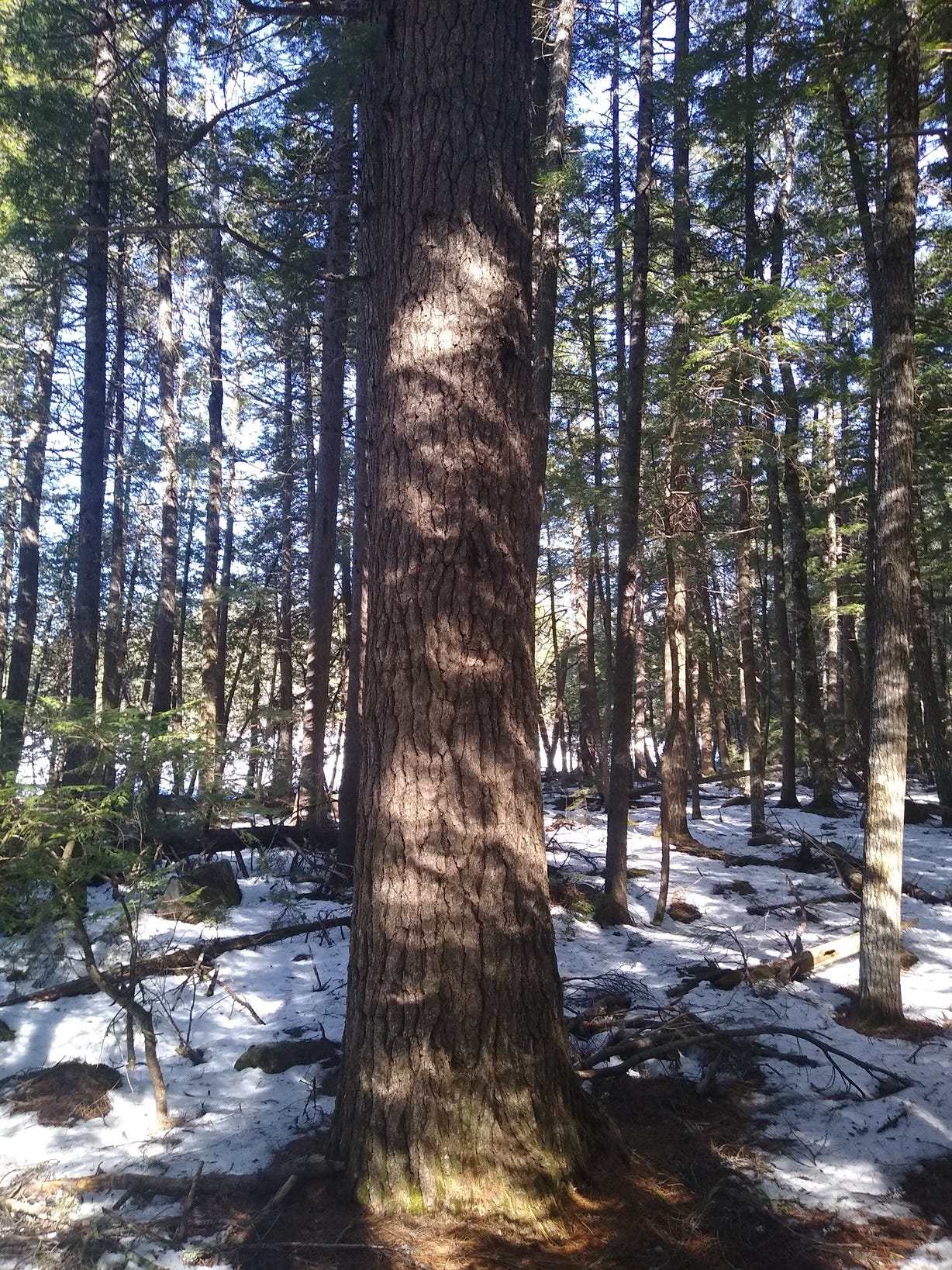


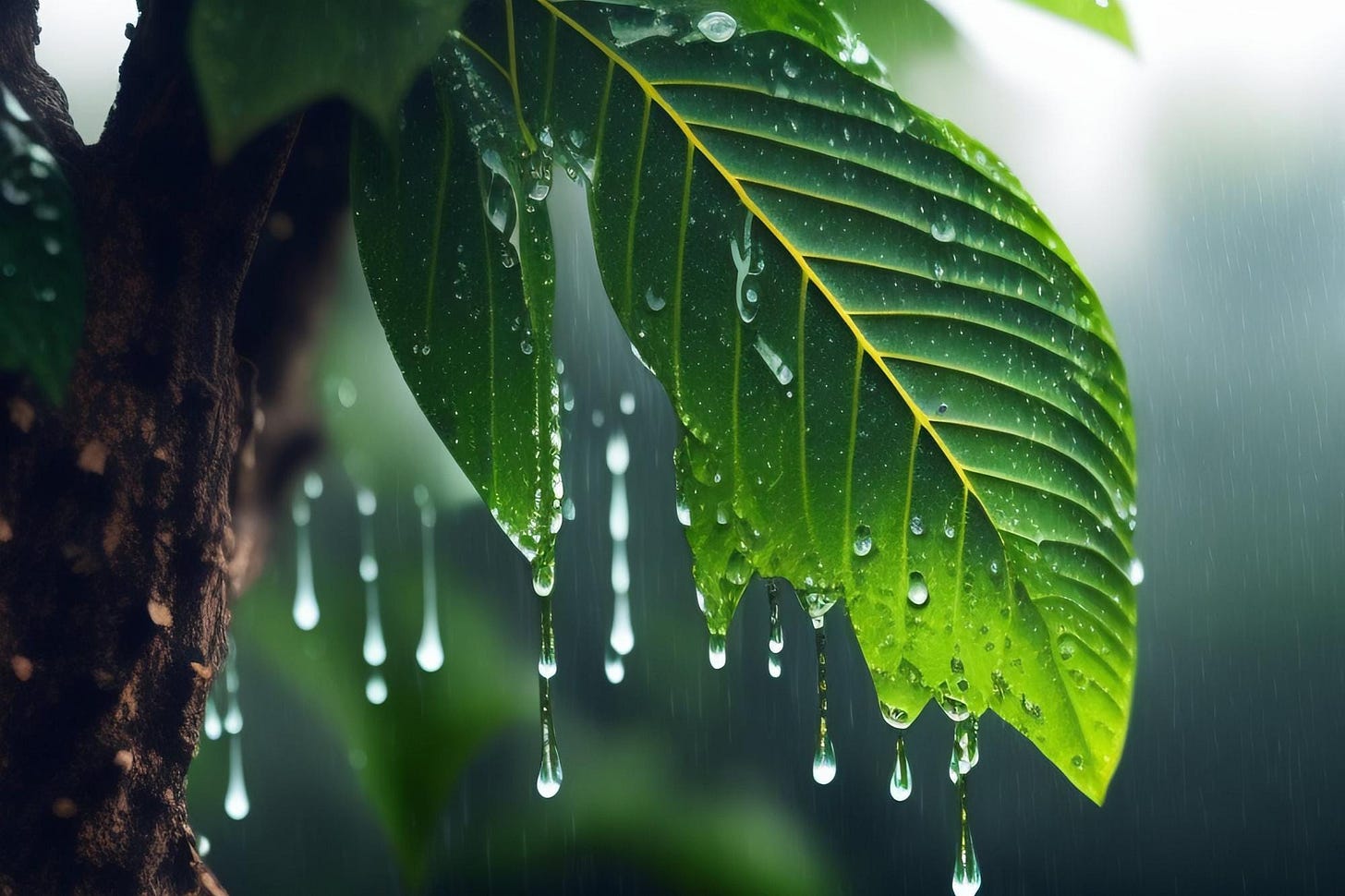
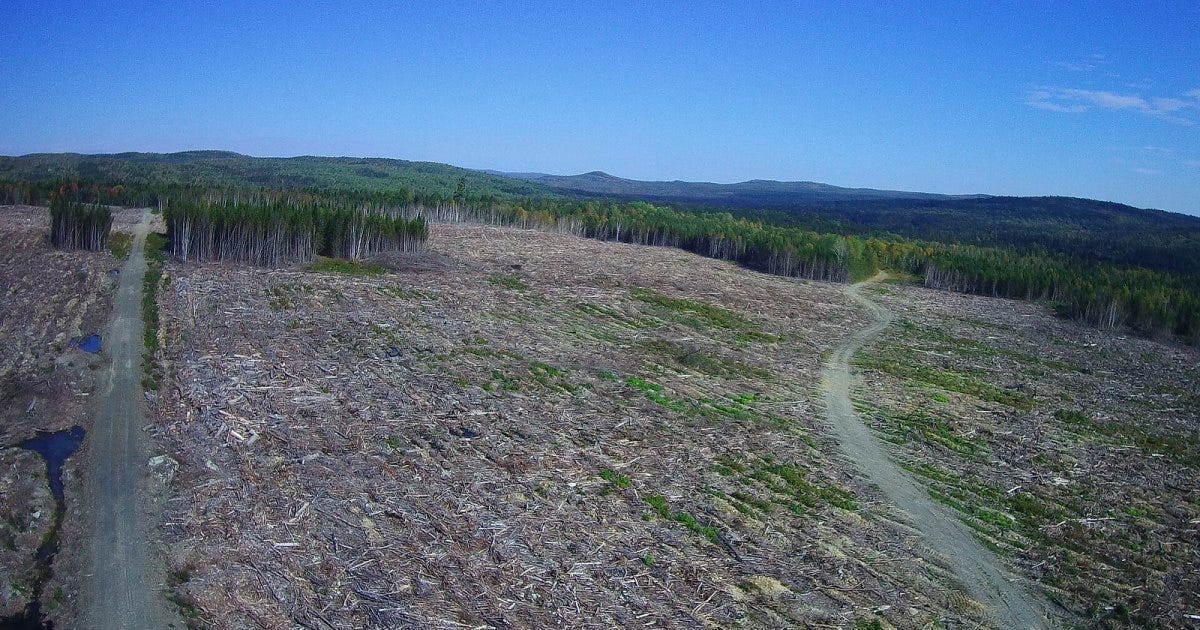
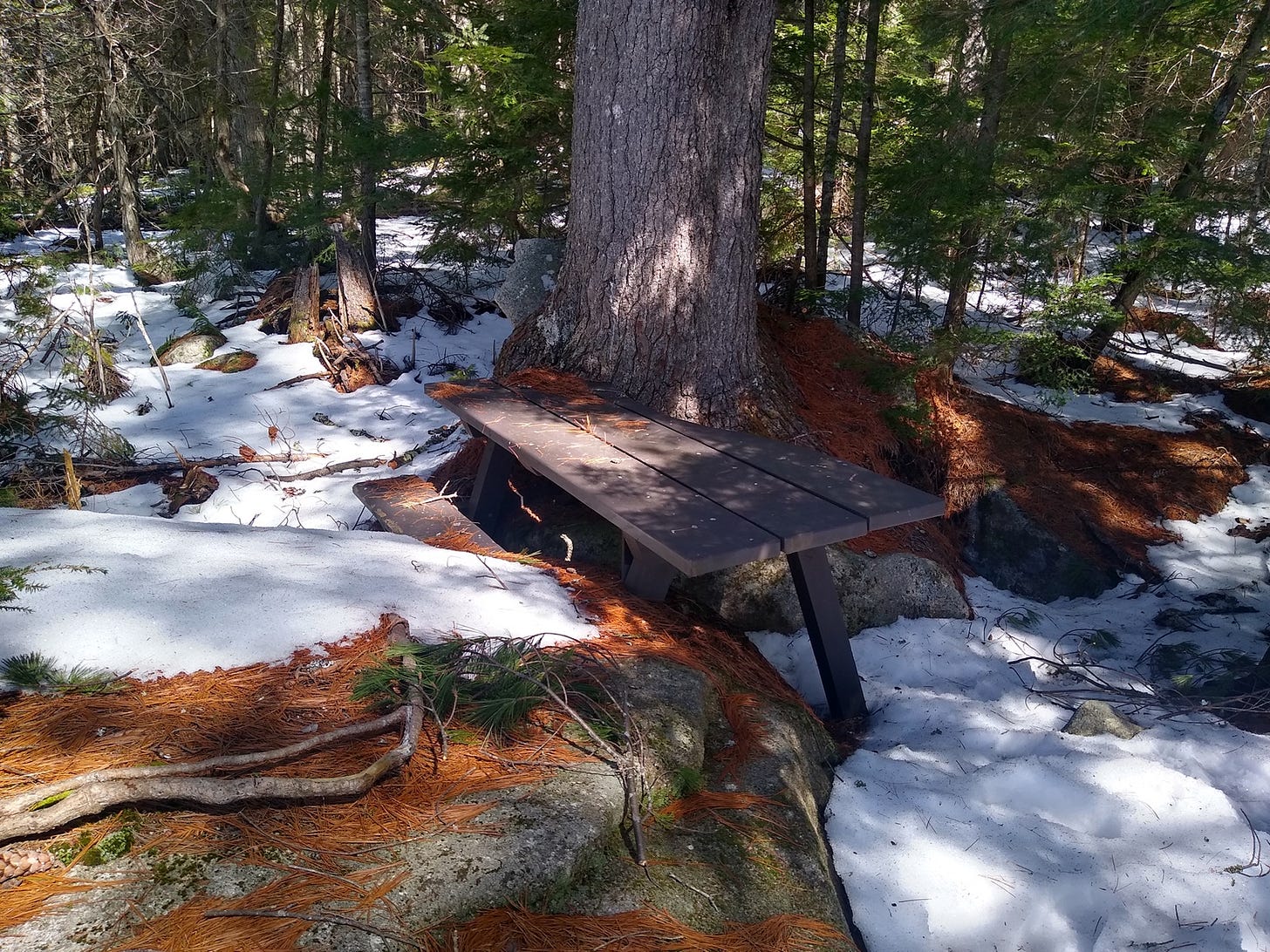

“Does a forest know grief?” I love this question. Got me in such a philosophical frame of mind. Grief is a powerful thing, something we experience when something is gone forever,and forests have this ability to regenerate and regrow in ways that we can’t. So I wonder if and how they experience it. Loss, sure, sadness, perhaps, but grief? I don’t know! I’ll be sitting with this one for a while, I think. Thanks for your wonderful words, as always.
I've always liked trees better than most people. There is so much governments could do: mandate smaller houses, lots large enough for a tree or two, bring back "victory gardens", refuse building permits for arrable land, mandate greywater systems and rainwater collection. In default of leadership by governments, those of us who care have to lead the way.